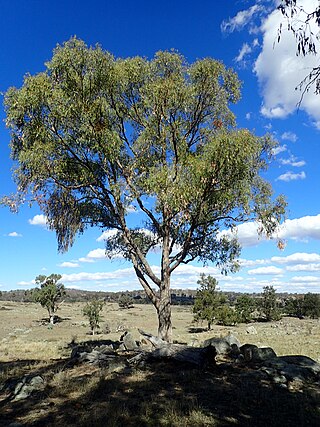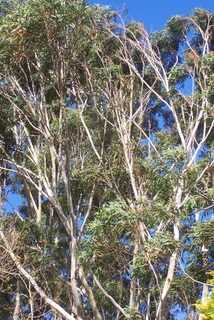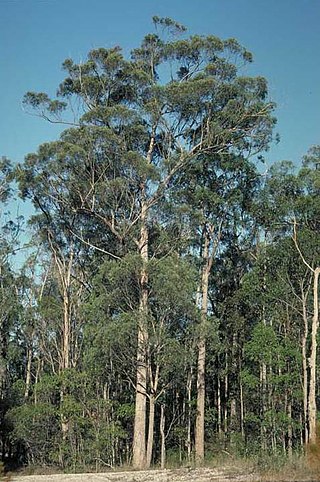
Eucalyptus melliodora, commonly known as yellow box, honey box or yellow ironbark, is a species of medium-sized to occasionally tall tree that is endemic to south-eastern, continental Australia. It has rough, flaky or fibrous bark on part or all of the trunk, smooth greyish to yellowish bark above. The adult leaves are lance-shaped to egg-shaped, the flower buds are arranged in groups of seven and the fruit is more or less hemispherical.

Eucalyptus nova-anglica, commonly known as the New England peppermint or black peppermint, is a species of small to medium-sized tree endemic to eastern Australia. It has thick, rough, fibrous bark on the trunk and larger branches, lance-shaped adult leaves, flower buds in groups of seven, white flowers and hemispherical or conical fruit.

Eucalyptus radiata, commonly known as the narrow-leaved peppermint or Forth River peppermint, is a species of tree that is endemic to south-eastern Australia. It has rough, fibrous to flaky bark on the trunk and larger branches, smooth grey bark on the thinner branches, lance-shaped to curved or almost linear leaves, flower buds in groups of eleven to twenty or more, white flowers and cup-shaped, hemispherical or shortened spherical fruit.

Eucalyptus caliginosa, commonly known as broad-leaved stringybark or New England stringybark, is a tree that is endemic to eastern Australia. It has stringy bark, lance-shaped or curved adult leaves, flower buds in groups of seven or nine, white flowers and more or less hemispherical fruit. It is common on the Northern Tablelands and North West Slopes of New South Wales and adjacent areas of Queensland.

Eucalyptus pilularis, commonly known as blackbutt, is a species of medium-sized to tall tree that is endemic to eastern Australia. It has rough, finely fibrous greyish bark on the lower half of the trunk, smooth white, grey or cream-coloured bark above, lance-shaped to curved adult leaves, flower buds in groups of between seven and fifteen, white flowers and hemispherical or shortened spherical fruit.

Eucalyptus notabilis, commonly known as Blue Mountains mahogany or mountain mahogany, is a species of small to medium-sized tree endemic to eastern Australia. It has rough, fibrous bark on the trunk and branches, lance-shaped to curved adult leaves, flower buds in groups of between seven and eleven, white flowers and hemispherical or conical fruit.

Eucalyptus acmenoides, commonly known as white mahogany or barayly, is a tree that is endemic to eastern Australia. It is a large tree with grey to reddish brown, stringy bark, lance-shaped leaves, oval to spindle-shaped buds and more or less hemispherical fruits. The two sides of adult leaves are very different shades of green.

Eucalyptus umbra, known as the broad-leaved white mahogany, is a species of small to medium-sized tree that is endemic to northern New South Wales. It has rough, fibrous to stringy bark on the trunk and branches, lance-shaped to curved adult leaves, flower buds in groups of seven to fifteen, white flowers and cup-shaped to hemispherical fruit.

Eucalyptus tenella, commonly known as narrow-leaved stringybark, is a species of small to medium-sized tree that is endemic to New South Wales. It has stringy bark, narrow lance-shaped to linear leaves, flower buds in group of seven to fifteen, white flowers and hemispherical fruit.

Eucalyptus psammitica, commonly known as bastard white mahogany, is a species of small to medium-sized tree that is endemic to eastern Australia. It has rough, stringy or fibrous, prickly bark on the trunk and branches, lance-shaped to curved adult leaves, flower buds in groups of between seven and eleven, white flowers and cup-shaped to hemispherical fruit.

Eucalyptus seeana, or narrow-leaved red gum, is a species of small to medium-sized tree that is endemic to eastern Australia. It has smooth bark, lance-shaped adult leaves, flower buds in groups of between seven and eleven, white flowers and hemispherical fruit.

Eucalyptus rigidula, commonly known as stiff-leaved mallee, is a species of mallee that is endemic to Western Australia. It has smooth bark, linear to narrow elliptic or narrow lance-shaped leaves, flower buds in groups of nine or eleven, creamy white flowers and barrel-shaped to hemispherical fruit.

Corymbia erythrophloia, commonly known as red bloodwood, variable-barked bloodwood, red-barked bloodwood or gum-topped bloodwood, is a species of tree that is endemic to Queensland. It has rough bark on the trunk and branches, egg-shaped or lance-shaped adult leaves, flower buds in groups of seven, creamy white flowers and urn-shaped to spherical fruit.

Eucalyptus carnea, known as the thick-leaved mahogany or broad-leaved white mahogany, is a species of tree that is endemic to coastal areas of eastern Australia. It has rough, stringy bark from the trunk to the thinnest branches, lance-shaped or curved adult leaves, flower buds in groups of between seven and eleven, white flowers and cup-shaped to hemispherical fruit.

Eucalyptus bakeri, commonly known as Baker's mallee or the mallee box, is a eucalypt that is endemic to eastern Australia. It has fibrous bark on the trunk and smooth white or grey bark above, narrow lance-shaped leaves, flower buds in groups of between seven and thirteen, white flowers and hemispherical or shortened spherical fruit.

Eucalyptus conglomerata, commonly known as the swamp stringybark, is a species of straggly tree or mallee that is endemic to Queensland. It has rough, fibrous "stringybark" lance-shaped to oblong adult leaves, flower buds in groups of eleven or more, white flowers and more or less barrel-shaped fruit.

Eucalyptus helidonica is a species of tree that is endemic to an area near Helidon in Queensland. It has rough, finely fibrous bark, lance-shaped or curved adult leaves that are paler on the lower surface, flower buds in groups of eleven or more, white flowers and shortened spherical or barrel-shaped fruit.
Eucalyptus latisinensis, commonly known as white mahogany, is a species of tree that is endemic to Queensland. It has rough, fibrous to stringy bark, lance-shaped to curved adult leaves, flower buds in groups of seven to eleven or more, white flowers and shortened spherical to hemispherical fruit.

Eucalyptus terrica is a species of small tree that is endemic to south-eastern Queensland. It has thin, rough, fibrous bark on the trunk and larger branches, smooth bark above, lance-shaped adult leaves, flower buds in groups of seven, white flowers and hemispherical fruit.

Eucalyptus virens, commonly known as the shiny-leaved ironbark, is a species of small to medium-sized tree that is endemic to Queensland. It has hard ironbark on the trunk and branches, narrow lance-shaped adult leaves, flower buds in groups of seven, white flowers and hemispherical fruit.




















